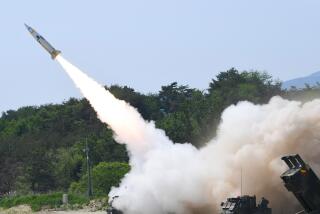South Korea’s Hand Opens to the North
- Share via
SEOUL — Richard A. Christenson, the American government’s chief representative in South Korea, urged me to repeat to every Korean I would run into while here what China’s Qian Qichen said in an interview last week in Beijing. “They need to know they are not alone,” Christenson said. “They need to know not everyone is out to get them.”
They need to know fate may finally be leaning toward Korea--a country that, for most of this century, has served as history’s tennis ball for the region’s bullies. So what was it that the Chinese foreign minister had said that so struck America’s top diplomat here? Just this: “China supports the reunification of the Korean peninsula. China adopts a practical approach toward the issue of the Korean peninsula.” This, from the man whose country for almost 50 years helped prop up its ideological mate, the now increasingly decrepit and disreputable North Korea.
Strictly speaking, that statement was not news; indeed, many Koreans understandably will take it with the proverbial grain of rice. Says Unification Minister Kwon O Ki, “Remember, there are a hundred faces to China. Right now, thankfully, the big faces are smiling.” But Koreans as well as Americans need to understand that such an unequivocal statement from someone at the very pinnacle of China’s foreign affairs establishment is not insignificant.
Why China’s kinder, gentler face toward South Korea? Basically, China doesn’t want a mess on that peninsula. Neither does the United States: There are almost 40,000 U.S. forces in South Korea with lots of family back in the United States who know that their loved ones live in the shadow of one of the world’s largest standing armies. Beyond that, in this communist non-paradise where there isn’t even enough food to go around, they’re building long-range North Korean missiles that could have the capability to toast not just Seoul and Tokyo but, someday perhaps parts of America’s West Coast as well. There’s also that aggressive North Korean missile export program to Iran and Syria.
Yes, Korea is relatively small, but its strategic role is not: This wisp of a Cold War remnant is the remaining ember that could ignite the world. Such tension can’t go on forever. In fact, in many Korean political circles, a consensus is emerging that the unification of South Korea, the world’s 11th largest economy, and North Korea, where much of the child population is either starving or facing malnutrition, may now be truly inescapable, no matter how daunting the costs to Seoul. The acceleration of the North’s decay only heightens the sense of inevitability for many in the South.
Koreans are now even coming to appreciate the Clinton administration’s aggressive efforts to denuclearize North Korea and bring peace to the peninsula. Last week I interviewed Lee Hoi Chang, the ruling party’s candidate to succeed the current Korean president in the planned December election, and the lead opposition candidate, Kim Dae Jung. I repeatedly asked them if they wanted to distance themselves from America’s effort to bring the North to the peace table. Neither did. Yet just a year ago, it seemed, America could hardly do any right by South Korea.
Let us also not discount the efforts of individuals and private citizens who do much for Korean peace. Indeed, the world needs to know about these many unrecognized, uncelebrated silent allies of peace, especially America’s large Korean American community of business people, religious and academic figures, philanthropists and ordinary people. Attending an international conference on Korean peace prospects here in Seoul last week, co-sponsored by USC, State Department official C. Kenneth Quinones, who has traveled to North Korea on official business no less than 13 times since 1992, agrees: “They have been sending aid [to North Korea], they have been there spiritually, they are the ones building bridges. They are the true peace process builders.” This is not to mention the enormous contribution of the International and Korean Red Cross, the United Nations’ World Food Program, UNICEF and other humanitarian groups whose ceaseless efforts to alleviate the tragic, growing North Korean famine are still not widely enough known. Worship Princess Di’s memory if you must; but spare a moment, and perhaps a few dollars, for groups like these.
At the conference, UC Berkeley professor Robert Scalapino, who has been writing insightfully about Korea and Asia since 1953, moved the audience when he said: “Fate seems to have been especially cruel to Korea. A people united by ethnicity, culture and language emerged from Japanese colonial rule only to be divided into two states increasingly hostile to each other.” A Korean American doctor told the story of his divided family. After the 1953 armistice, one son wound up in the North, but the mother never lost hope that someday the family would be reunited. In 1991 the Korean Broadcasting Service’s Separated Family Search Program, discovering that indeed the lost son was still alive in the North, arranged for him to visit the South on a special visa. Just before he was able to come, his mother, 83, died--of old age and perhaps, too, of a broken heart. Shortly after that incident, and partly in response to it, the U.S. Congress created the Task Force on Korean Family Reunification. Now, the hope is that Korea itself will not have to wait as fatally long as that mother.
More to Read
Sign up for Essential California
The most important California stories and recommendations in your inbox every morning.
You may occasionally receive promotional content from the Los Angeles Times.













